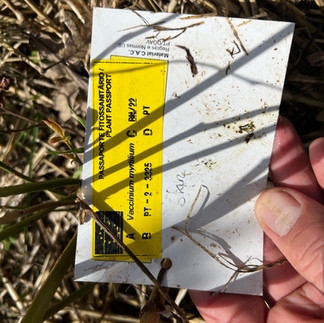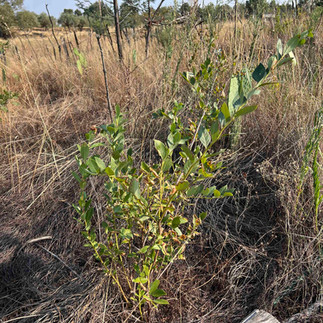Vaccinium corymbosum 'Star' (Southern Highbush Blueberry)
- Herman Kraut

- Aug 25
- 4 min read
Common Name: Southern Highbush Blueberry 'Star'
Scientific Name: Vaccinium corymbosum 'Star'
Plant Family: Ericaceae
Lifecycle: Perennial
The 'Star' blueberry is a Southern Highbush variety prized for its early ripening, large firm berries, and adaptability to warmer climates like Zone 8a. On our land, it’s showing promise even in full sun and without deliberate soil acidification, though canopy shade from maturing trees may improve long-term yields. Beyond fresh eating, blueberries like 'Star' bring pollinator value and a touch of forest-edge beauty to a Mediterranean homestead.
For in-depth guides and curated tools, be sure to check out our Recommended Books & Resources below.
Plant Profile
Characteristic | Information |
Climate Suitability | USDA Zones 7–10; Köppen Csa (Mediterranean) |
Sun / Shade Needs | Full sun preferred; partial shade tolerated |
Watering Needs | Moderate; consistent moisture without waterlogging |
Soil Preferences | Acidic (pH 4.5–5.5), well-drained, rich in organic matter |
Spacing & Height | 1.2–1.5 m spacing; 1.5–2 m height |
Propagation Method(s) | Softwood cuttings, hardwood cuttings, or tissue culture |
Planting Timeline | Plant in late winter to early spring (before bud break) |
Companion Plants | Azaleas, rhododendrons, cranberries, strawberries |
Edible / Medicinal / Ecological Uses | Edible fruit, high in antioxidants; attracts bees and other pollinators |
Pest / Disease Considerations | Susceptible to root rot in poorly drained soils; watch for aphids, birds |
Pruning / Harvest Notes | Light pruning after harvest; fruit ripens early to mid-spring in Zone 8a |
Quick Plant Reference
Care Level: Moderate
Optimal Sunlight: Full sun (6–8 hrs)
Water Needs: Regular, moisture-retentive soil
Mature Size: 1.5–2 m (5–6.5 ft) height, 1.2–1.5 m spread
Soil Type: Acidic, organic-rich, well-drained
Humidity: Medium
Toxicity: Non-toxic to humans; mildly toxic to pets if ingested in quantity
Beneficial Pollinators: Bees, bumblebees, hoverflies
Health Benefits: Rich in antioxidants, vitamins C and K, dietary fiber
Chilling Hours: ~300–400 hours
Pollination Requirements: Partially self-fertile but heavier crops with cross-pollination
Our Vaccinium corymbosum 'Star' Application @ Tough Kraut
We planted our 'Star' blueberry along the east pathway to our elevated IBC tank in March 2023. Despite full-day summer sun and no soil acidification measures, it produced a small handful of berries in its second season. We’re counting on the evolving tree canopy nearby to provide moderated shade and microclimate stability, boosting future productivity.
Step-by-Step Growing Guide
Note: Blueberries often spark troubleshooting and FAQ discussions, especially around soil pH and watering habits. If your 'Star' seems slow to establish, patience and consistent care usually pay off.
1. Choose the Right Site
Select a sunny, well-drained area with some wind protection. Partial shade in hot climates helps reduce stress.
2. Prepare the Soil
Amend with organic matter (pine needles, composted bark) to encourage acidity. If natural soil is alkaline, consider raised beds or containers.
3. Plant the Shrub
Set root ball slightly above soil line and mulch heavily with pine bark or wood chips to conserve moisture.
4. Water Consistently
Keep soil moist, especially during the first two years. Avoid drying out during fruit set.
5. Ensure Proper Pollination
For best yields, plant at least one other Southern Highbush variety nearby to encourage cross-pollination.
6. Prune Annually
Remove weak or crossing branches in late winter. Aim for an open center to improve airflow and berry quality.
7. Manage Pests and Diseases
Protect ripening fruit from birds with netting. Watch for fungal issues if soil stays wet.
8. Harvest and Store
Pick when berries are fully blue and detach easily. Store fresh in the fridge for up to a week or freeze for long-term use.
9. Note
If yields seem low at first, remember blueberries often take 2–3 years to establish. Mulch renewal and organic feedings improve long-term results.
Kraut Crew Insight
Our Vaccinium corymbosum 'Star' blueberry may not be the quickest to establish, but it’s shown resilience under less-than-perfect soil prep. Sometimes, the best teacher on the homestead is a plant that thrives despite our shortcuts.
Photos
Herman’s Tough Kraut Field Notes: Solving Southern Highbush Blueberry Cultivation Challenges
Like most blueberries, 'Star' comes with its fair share of troubleshooting questions. Here are some FAQs we’ve faced and how we’ve worked around them:
Q: My blueberry is in full sun, but growth seems slow. What can I do?
A: In Zone 8a, heat stress is real. Allow natural canopy trees to grow in around the blueberry, or plant nurse shrubs to provide dappled shade.
Q: Do I really need acidic soil for 'Star'?
A: Ideally, yes. But as our experience shows, it will survive and fruit modestly in neutral soils. Long-term, use mulches like pine needles and composted oak leaves to naturally lower pH.
Q: Birds keep eating my berries. Any tips?
A: Bird netting or reflective tape works best. Alternatively, plant decoy berry shrubs nearby to distract them.
Q: Why are leaves turning yellow?
A: Often a sign of iron deficiency from high soil pH. Apply chelated iron or adjust mulching strategies to improve uptake.
Q: Can I grow just one 'Star' blueberry?
A: Yes, it’s self-fertile. However, pairing with another Southern Highbush variety like ‘Biloxi’ will increase berry size and yields.
Recommended Books & Resources
Books
The Berry Grower’s Companion by Barbara L. Bowling
Practical guide covering everything from planting to harvesting small fruits.
The Highbush Blueberry and Its Management by Robert E. Gough
An in-depth, science-backed guide focused on highbush blueberry cultivation, including Southern cultivars like ‘Biloxi’, covering variety selection, pruning, and soil management.
Grow the Best Blueberries by Vladimir G. Shutak & Robert E. Gough
A practical, easy-to-follow handbook for home gardeners on planting, caring for, and harvesting southern highbush blueberries.
Highbush Blueberry Production Guide by Cooperative Extension
A trusted, research-based manual with comprehensive insights into blueberry production, soil prep, planting, and maintenance. Available as a free PDF download.
Resources
Digital Soil pH Meter
Keep your blueberry soil in the perfect acidic range (4.5–5.5) with precision pH checks.
Hand-Forged Japanese Pruning Shears
Premium shears for clean cane renewal cuts that last a lifetime.
Protective Bird Net Cover
Lightweight netting to protect ripening berries from birds and critters.
Tough Kraut Resources
Our hand-picked homestead gear and orchard essentials, tested on real soil and sun.
Entry last updated: 2025-08-23
This post is part of the Tough Kraut Plant Library, documenting what really grows on our off-grid homestead in Central Portugal.













Comments